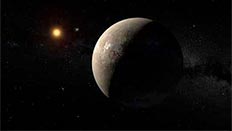Methods of detection
The choices
There are many different ways in which exoplanets can be detected, each with varying degrees of success. The most popular and effective methods of detection are the Transit and Radial Velocity methods; however it is interesting to look at some of the others that are available.
The Perryman Tree details the range of detection methods. Some of the most interesting of these are explored more below:
Gravitational Microlensing
Planets can cause the starlight of distant stars to bend around them, distorting that light. These distortions are measurable here on Earth, though their effects are often very small! The bending of starlight around massive objects was predicted by Einstein in his General Theory of Relativity.
Astrometry
The Astrometry method approaches the idea of direct imaging in a different light - instead of looking for the planet, the star's movement on the sky is very closely monitored. Any regular ‘wobble’ in the star’s position might be caused by the gravitational tug of a planetary companion. Astrometry is explored in much more detail in our guide (PDF - 2.2 Mb).
Eclipsing Binary Minima Timing
Stars often aren't found alone but instead come in pairs. In these instances the two stars orbit their common centre of mass. If their orbit is aligned along our line of sight, one will pass in front of and then behind the other. In both cases we would see a reduction in the amount of starlight we receive from the pair as one is, at least partially, hidden. The timing between these reductions in brightness should be constant. However, if a planet was to orbit one of these stars, these timings would be disrupted. Therefore, any irregularity detected could be evidence of a planet in these cases.

